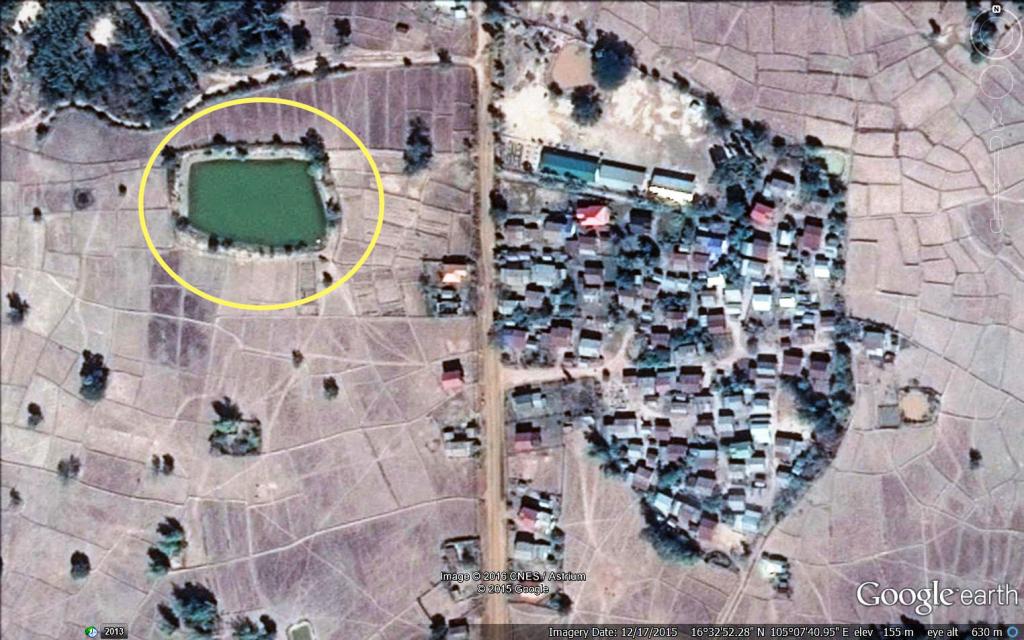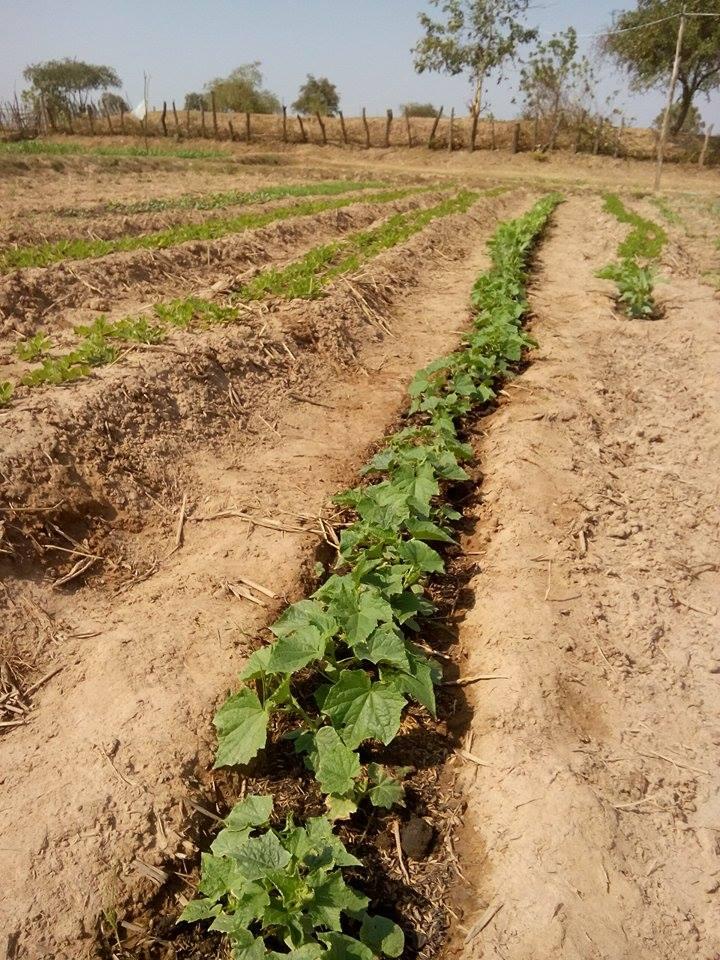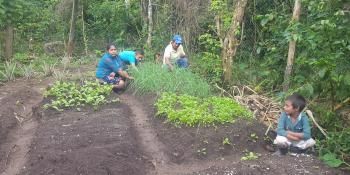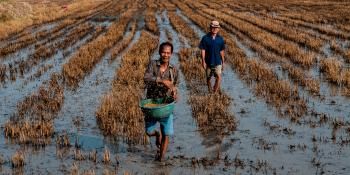Resource sharing for dry season crops: a tale of the village pond

A village pond could provide the people of Ban Phailom in Laos with the much-needed water for their vegetables during the dry season but resource access is a serious concern. How were they able to sort out the problem?
In the small village of Ban Phailom, located in central Laos in the province of Savannakhet, water resources during the dry season are extremely scarce. Previous attempts to exploit groundwater resulted in several drilled wells, with one in the front yard of the village school. But farmers quickly learned of rock salt in the region’s geology, thus, all crops in their vegetable garden die because of excess salt coming from the irrigation groundwater. In the absence of river streams, and with salt in the region’s geology, the only viable source of water for the village in the dry season is rainfall stored in natural storages such as ponds.
The valued village pond
Located across the main pathway from Ban Phailom, in close proximity to the 116 households (total population of 669) that make up the village is a unique, large pond. According to the village head, the pond formed naturally, or likely as a result of the ‘bomb cratering effect’ during the Vietnam War, as is often observed in Laos. Due to its shallowness, the pond used to dry up a couple of months after the beginning of the dry season, thus limiting villagers’ water uses to bathing, washing clothes and fishing.

Community pond of the village Ban Phailom, surrounded by empty paddy fields during the dry season. The village is located just on the right side of the road. Photo: GoogleEarth
Researchers from the International Water Management Institute (IWMI), the World Fish Center (WorldFish) and the International Rice Research Institute (IRRI) posed this question upon visiting Ban Phailom in January 2015. Why weren’t farmers of the village utilizing the abundant water resources in this pond to produce crops (e.g. vegetables) by irrigation? During the dry season in particular, which stretches from November to April, the pond was the only available water source near the village. In 2007, a monk who had spent several years in the USA came back to Ban Phailom, his native village, and dedicated USD 800 of his own money to deepen and widen the pond. With this expanded storage capacity, the pond remains full of water throughout the year. This investment offered a significant benefit to the villagers – but could villagers be taking better advantage of the water in their community pond?
Access to village pond
While the pond is a community resource, the land surrounding the pond has a distinct owner. Farmers of the village explained that the owner of this land focuses on wet season rice cultivation, and is not interested in irrigating his land during the dry season. Other farmers who would like to irrigate with water from the pond have land at a much further distance from the pond.
When asked why the farmers don’t fill transportable tanks to bring the water to their field, they said that, because of the absence of clear rules governing water access and use of this pond, everyone is afraid to take the water beyond modest household uses. They feel as if they would be stealing the water from other farmers.
For these two reasons, land not available for dry season irrigation in the vicinity of the pond and lack of clear regulation of water access, the pond, although a unique water resource close to the village, has remained untapped for irrigation and agriculture for many years.
Convening stakeholders
This lost potential was revisited in October 2015 when a training workshop on vegetable gardens was organized by the National Agriculture and Forestry Research Institute (NAFRI), IRRI and CUSO International as part of the CGIAR Research Program on Climate Change, Agriculture and Food Security (CCAFS). After some discussions, a group of interested farmers was formed. It became clear that the community pond is the only affordable option for farmers who wanted to start growing vegetables near the village.
Several meetings with the village head and the owner of the land around the pond followed. Initially, the owner was reluctant to allow other farmers to grow vegetables on his land during the dry season. He mentioned that vegetables could impoverish his soil, thus compromising his rice crop in the wet season. The digging of ditches and building of small dikes to irrigate watermelons were also seen as an impediment to preparing land for wet season rice production. As a compromise, farmers promised not to grow watermelons, thus granted access to the coveted land in order to grow vegetables around the pond.
Vegetables to diversify diets in Ban Phailom
In villages such as Ban Phailom, vegetables play a key role in diets, providing nutrients that are not present in staple foods like rice. Malnutrition is a key problem in Laos, and promoting dry season irrigation of vegetable gardens (using water from a pond) is a way to alleviate this problem and improve farmers’ livelihoods.
As part of the CCAFS project on upscaling climate-smart technologies in Southeast Asia, in November 2015, NAFRI, IWMI and local authorities including the District Agriculture and Forestry Office (DAFO) and the Provincial Agriculture and Forestry Office (PAFO) set up a demonstration site for vegetable gardening around Ban Phailom’s village pond.
Two electric pumps and various vegetable seeds were purchased. This vegetable garden will be maintained by 12 households nearby the pond. Each of the 12 households is expected to irrigate a vegetable plot of 10 m × 15 m. The volume of water stored in the pond at the beginning of the dry season (about 900 m3) will be sufficient to sustain vegetable production through the dry season.

(A) The two electric pumps installed on the edge of the community pond. (B) Farmers prepare the land near the pond for growing vegetables. Photo: G. Lacombe/IWMI
By simply organizing a few meetings, which gathered farmers, local authorities (i.e. village head, DAFO/PAFO), and the owner of the land surrounding the pond, the village of Ban Phailom was able to come to an agreement and leverage a unique water resource for the greater benefit of the community. This experience exemplifies the concept of low-hanging fruit (or vegetables) and sets a prime example for other villages in the region where community ponds exist and where vegetable production remains moderate. In the province of Savannakhet alone, more than 16,000 ponds have been inventoried. In the next steps of the project, IWMI will explore how to replicate this type of intervention in other villages in Southeast Asia.

Young shoots are irrigated sparingly to save water. The pond is located in the background, hidden behind the soil embankment. Photo: G. Lacombe/IWMI
Guillaume Lacombe is a Senior Researcher - Hydrology for the International Water Management Institute.


